YAMAHA V1 2015 Service Manual
Manufacturer: YAMAHA, Model Year: 2015, Model line: V1, Model: YAMAHA V1 2015Pages: 94, PDF Size: 3.01 MB
Page 41 of 94
![YAMAHA V1 2015 Service Manual Equipment operation
35
breaks, the watercraft could fall, which
could result in severe injury.
[EWJ00022]
EJU34865
Reboarding step (V1 Sport)
The reboarding step is used to assist in re-
boarding the YAMAHA V1 2015 Service Manual Equipment operation
35
breaks, the watercraft could fall, which
could result in severe injury.
[EWJ00022]
EJU34865
Reboarding step (V1 Sport)
The reboarding step is used to assist in re-
boarding the](/img/51/51943/w960_51943-40.png)
Equipment operation
35
breaks, the watercraft could fall, which
could result in severe injury.
[EWJ00022]
EJU34865
Reboarding step (V1 Sport)
The reboarding step is used to assist in re-
boarding the watercraft from the water.
When boarding the watercraft, push the re-
boarding step down until it stops. The step
returns automatically to its original position
when released. WARNING! Do not use the
reboarding step to lift the watercraft. The
reboarding step is not designed to support
the watercraft’s weight. If the reboardingstep breaks, the watercraft could fall,
which could result in severe injury.
[EWJ01212]
NOTICE
ECJ00743
Use the reboarding step only to board the
watercraft in the water. Do not use the re-
boarding step for any other purpose. The
watercraft can be damaged.
EJU34873Bow eye
The bow eye is used to attach a rope to the
watercraft when transporting, mooring, or
1Handgrip
1
1Reboarding step
1
UF2P72E0.book Page 35 Tuesday, August 26, 2014 10:08 AM
Page 42 of 94
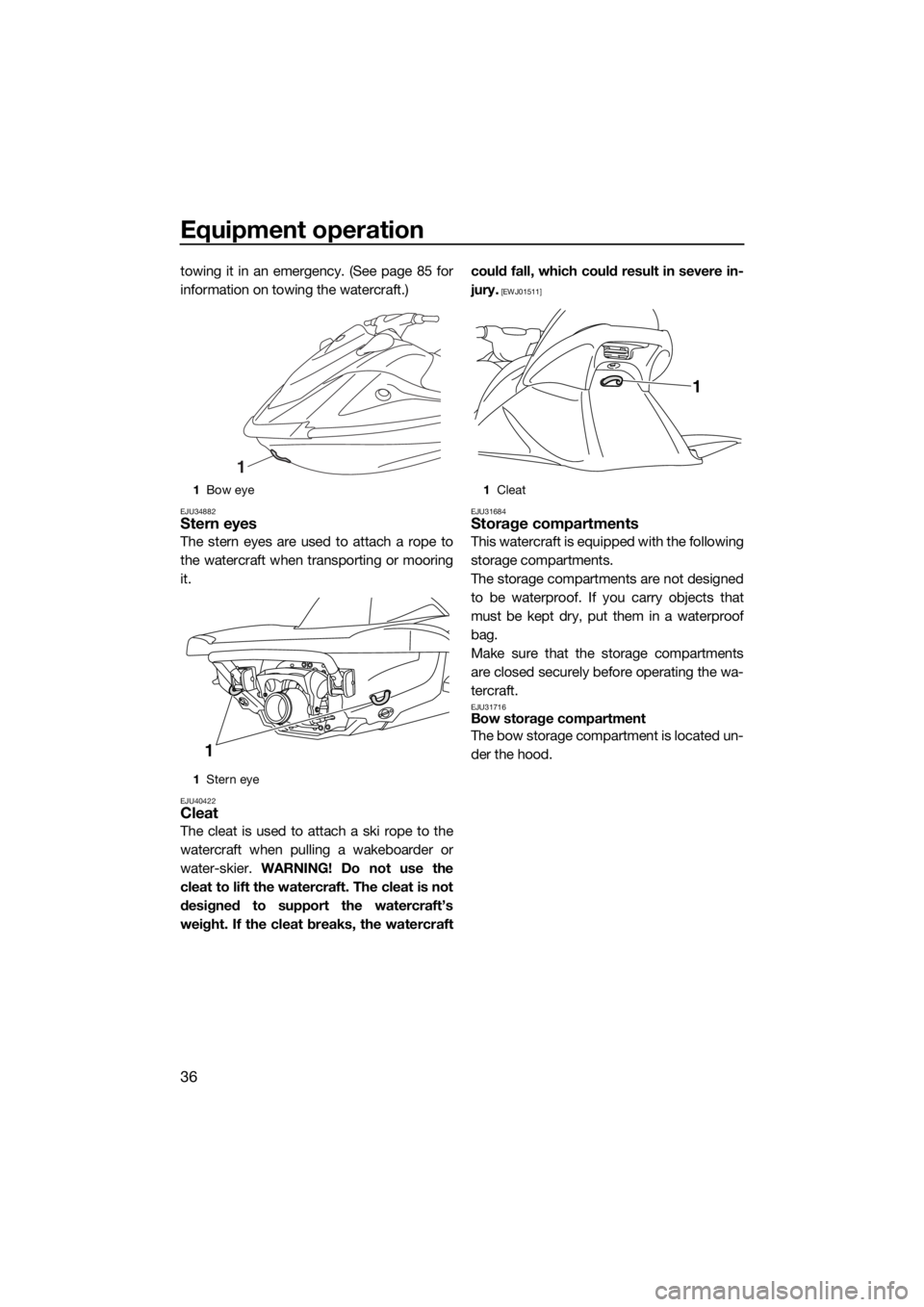
Equipment operation
36
towing it in an emergency. (See page 85 for
information on towing the watercraft.)
EJU34882Stern eyes
The stern eyes are used to attach a rope to
the watercraft when transporting or mooring
it.
EJU40422Cleat
The cleat is used to attach a ski rope to the
watercraft when pulling a wakeboarder or
water-skier. WARNING! Do not use the
cleat to lift the watercraft. The cleat is not
designed to support the watercraft’s
weight. If the cleat breaks, the watercraftcould fall, which could result in severe in-
jury.
[EWJ01511]
EJU31684
Storage compartments
This watercraft is equipped with the following
storage compartments.
The storage compartments are not designed
to be waterproof. If you carry objects that
must be kept dry, put them in a waterproof
bag.
Make sure that the storage compartments
are closed securely before operating the wa-
tercraft.
EJU31716Bow storage compartment
The bow storage compartment is located un-
der the hood.
1Bow eye
1Stern eye
1
1
1Cleat
1
UF2P72E0.book Page 36 Tuesday, August 26, 2014 10:08 AM
Page 43 of 94
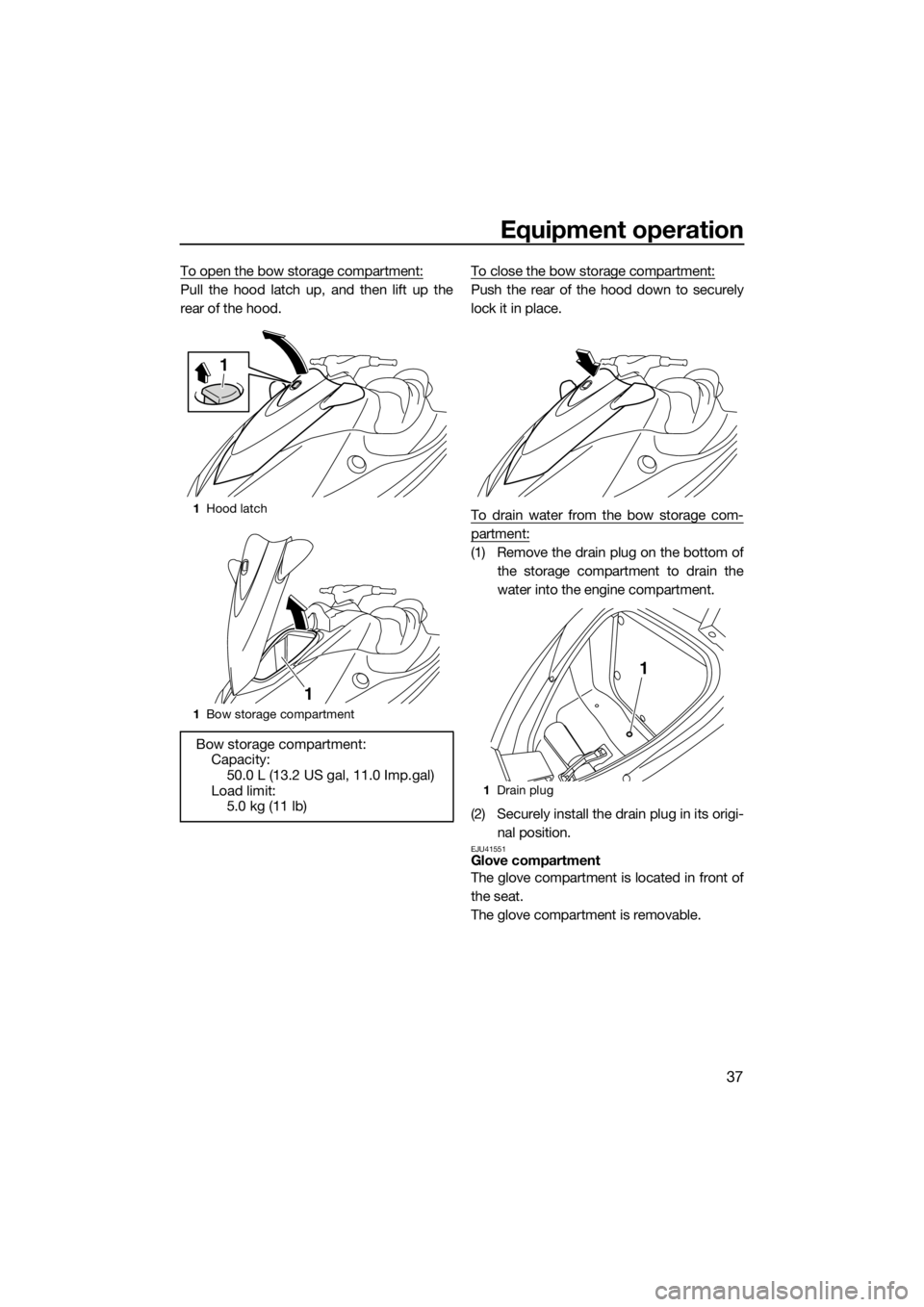
Equipment operation
37
To open the bow storage compartment:
Pull the hood latch up, and then lift up the
rear of the hood.To close the bow storage compartment:Push the rear of the hood down to securely
lock it in place.
To drain water from the bow storage com-
partment:
(1) Remove the drain plug on the bottom of
the storage compartment to drain the
water into the engine compartment.
(2) Securely install the drain plug in its origi-
nal position.
EJU41551Glove compartment
The glove compartment is located in front of
the seat.
The glove compartment is removable.
1Hood latch
1Bow storage compartment
Bow storage compartment:
Capacity:
50.0 L (13.2 US gal, 11.0 Imp.gal)
Load limit:
5.0 kg (11 lb)
1
1
1Drain plug
1
UF2P72E0.book Page 37 Tuesday, August 26, 2014 10:08 AM
Page 44 of 94
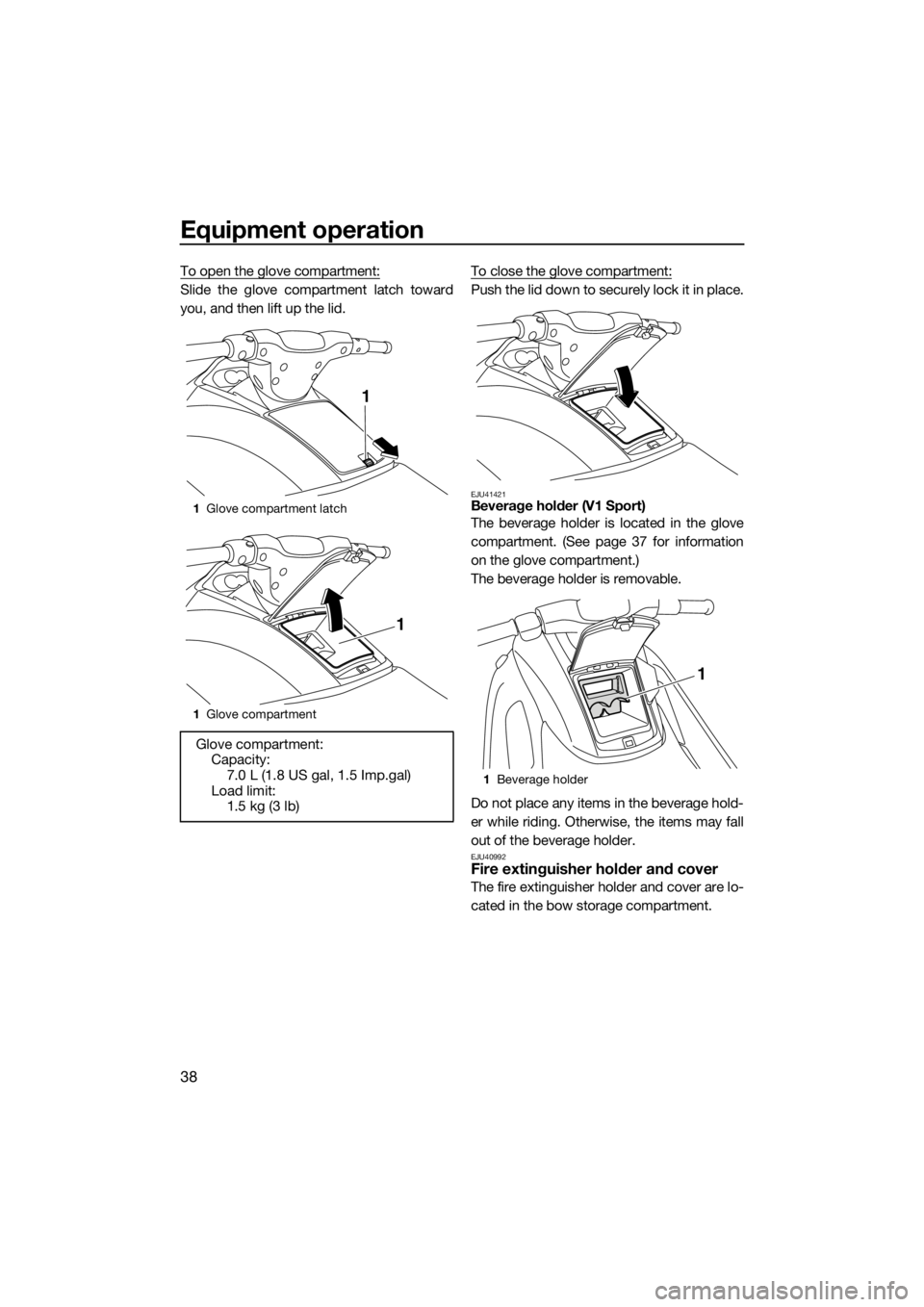
Equipment operation
38
To open the glove compartment:
Slide the glove compartment latch toward
you, and then lift up the lid.To close the glove compartment:Push the lid down to securely lock it in place.
EJU41421Beverage holder (V1 Sport)
The beverage holder is located in the glove
compartment. (See page 37 for information
on the glove compartment.)
The beverage holder is removable.
Do not place any items in the beverage hold-
er while riding. Otherwise, the items may fall
out of the beverage holder.
EJU40992Fire extinguisher holder and cover
The fire extinguisher holder and cover are lo-
cated in the bow storage compartment.
1Glove compartment latch
1Glove compartment
Glove compartment:
Capacity:
7.0 L (1.8 US gal, 1.5 Imp.gal)
Load limit:
1.5 kg (3 lb)
1
1
1Beverage holder
1
UF2P72E0.book Page 38 Tuesday, August 26, 2014 10:08 AM
Page 45 of 94
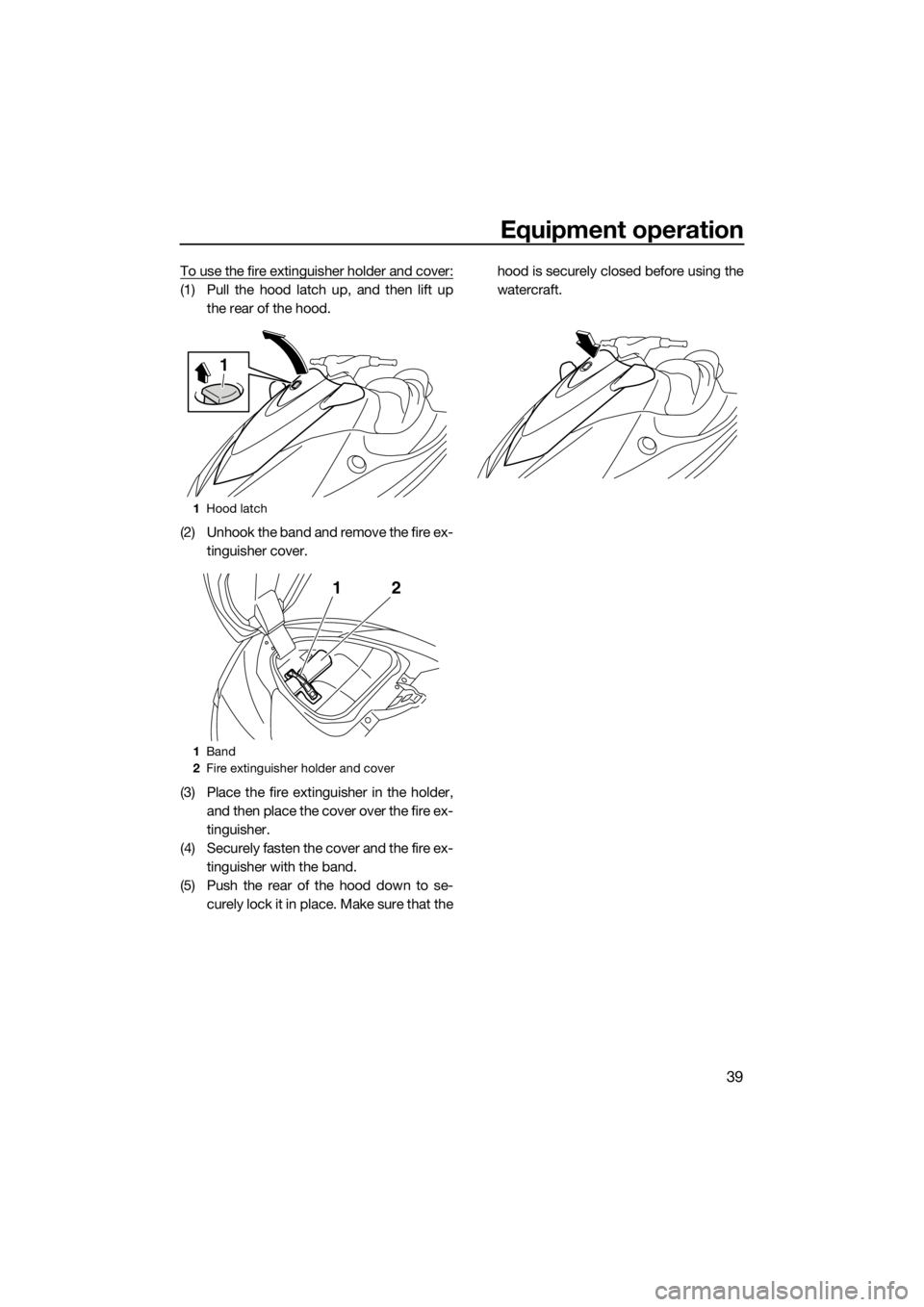
Equipment operation
39
To use the fire extinguisher holder and cover:
(1) Pull the hood latch up, and then lift up
the rear of the hood.
(2) Unhook the band and remove the fire ex-
tinguisher cover.
(3) Place the fire extinguisher in the holder,
and then place the cover over the fire ex-
tinguisher.
(4) Securely fasten the cover and the fire ex-
tinguisher with the band.
(5) Push the rear of the hood down to se-
curely lock it in place. Make sure that thehood is securely closed before using the
watercraft.
1Hood latch
1Band
2Fire extinguisher holder and cover
1
12
UF2P72E0.book Page 39 Tuesday, August 26, 2014 10:08 AM
Page 46 of 94
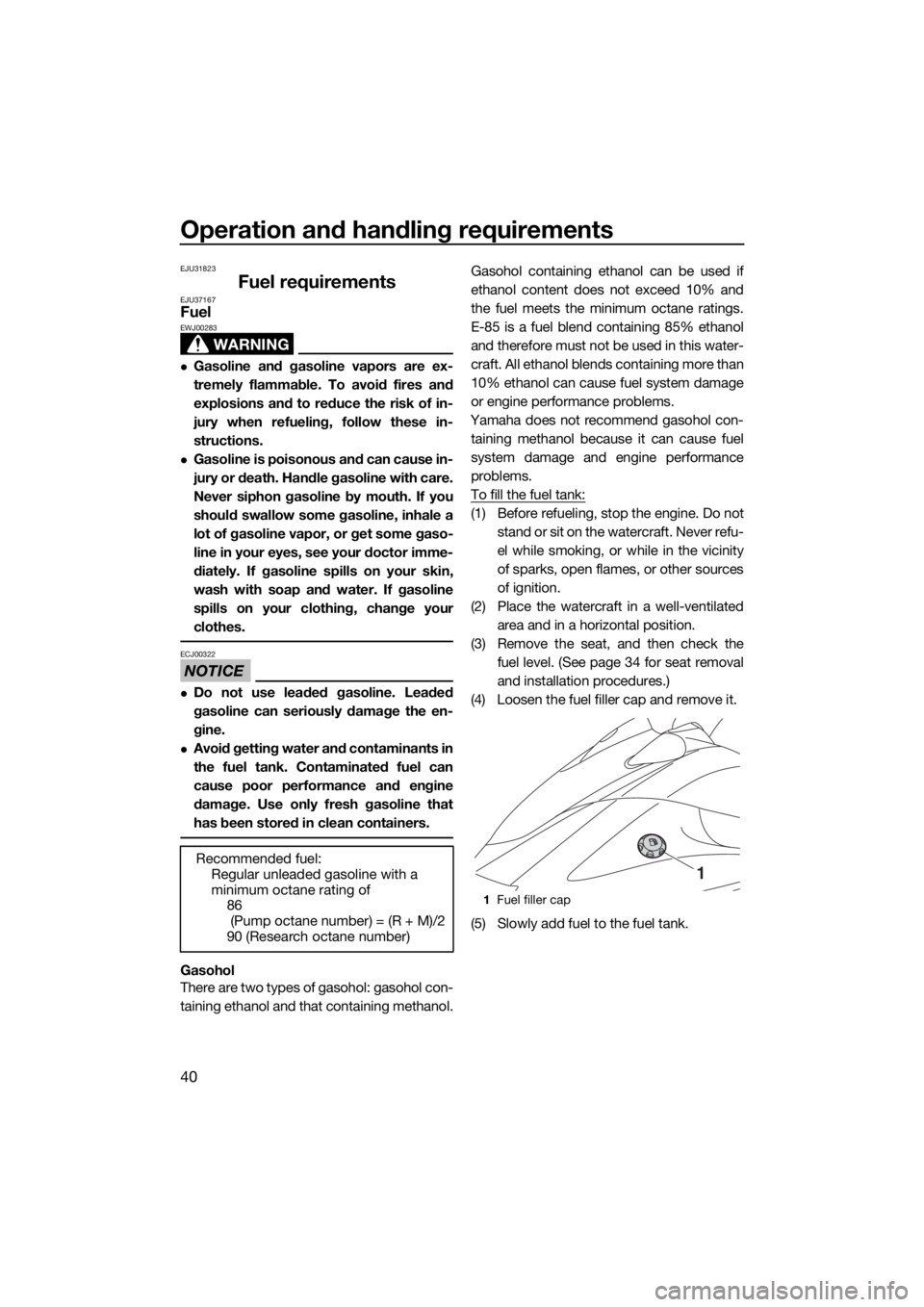
Operation and handling requirements
40
EJU31823
Fuel requirementsEJU37167Fuel
WARNING
EWJ00283
Gasoline and gasoline vapors are ex-
tremely flammable. To avoid fires and
explosions and to reduce the risk of in-
jury when refueling, follow these in-
structions.
Gasoline is poisonous and can cause in-
jury or death. Handle gasoline with care.
Never siphon gasoline by mouth. If you
should swallow some gasoline, inhale a
lot of gasoline vapor, or get some gaso-
line in your eyes, see your doctor imme-
diately. If gasoline spills on your skin,
wash with soap and water. If gasoline
spills on your clothing, change your
clothes.
NOTICE
ECJ00322
Do not use leaded gasoline. Leaded
gasoline can seriously damage the en-
gine.
Avoid getting water and contaminants in
the fuel tank. Contaminated fuel can
cause poor performance and engine
damage. Use only fresh gasoline that
has been stored in clean containers.
Gasohol
There are two types of gasohol: gasohol con-
taining ethanol and that containing methanol.Gasohol containing ethanol can be used if
ethanol content does not exceed 10% and
the fuel meets the minimum octane ratings.
E-85 is a fuel blend containing 85% ethanol
and therefore must not be used in this water-
craft. All ethanol blends containing more than
10% ethanol can cause fuel system damage
or engine performance problems.
Yamaha does not recommend gasohol con-
taining methanol because it can cause fuel
system damage and engine performance
problems.
To fill the fuel tank:
(1) Before refueling, stop the engine. Do not
stand or sit on the watercraft. Never refu-
el while smoking, or while in the vicinity
of sparks, open flames, or other sources
of ignition.
(2) Place the watercraft in a well-ventilated
area and in a horizontal position.
(3) Remove the seat, and then check the
fuel level. (See page 34 for seat removal
and installation procedures.)
(4) Loosen the fuel filler cap and remove it.
(5) Slowly add fuel to the fuel tank. Recommended fuel:
Regular unleaded gasoline with a
minimum octane rating of
86
(Pump octane number) = (R + M)/2
90 (Research octane number)
1Fuel filler cap
1
UF2P72E0.book Page 40 Tuesday, August 26, 2014 10:08 AM
Page 47 of 94
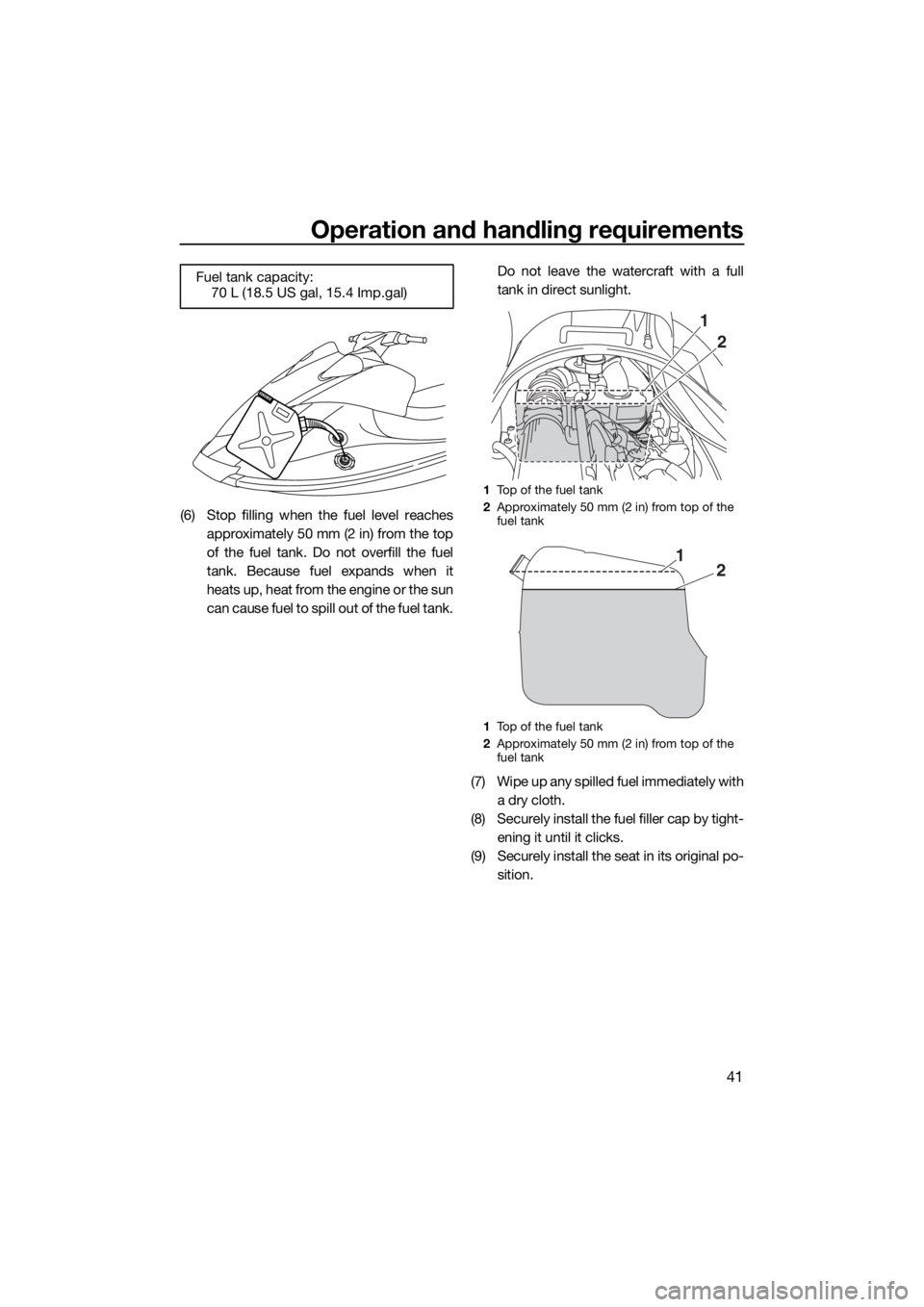
Operation and handling requirements
41
(6) Stop filling when the fuel level reaches
approximately 50 mm (2 in) from the top
of the fuel tank. Do not overfill the fuel
tank. Because fuel expands when it
heats up, heat from the engine or the sun
can cause fuel to spill out of the fuel tank.Do not leave the watercraft with a full
tank in direct sunlight.
(7) Wipe up any spilled fuel immediately with
a dry cloth.
(8) Securely install the fuel filler cap by tight-
ening it until it clicks.
(9) Securely install the seat in its original po-
sition. Fuel tank capacity:
70 L (18.5 US gal, 15.4 Imp.gal)
1Top of the fuel tank
2Approximately 50 mm (2 in) from top of the
fuel tank
1Top of the fuel tank
2Approximately 50 mm (2 in) from top of the
fuel tank
2
1
21
UF2P72E0.book Page 41 Tuesday, August 26, 2014 10:08 AM
Page 48 of 94
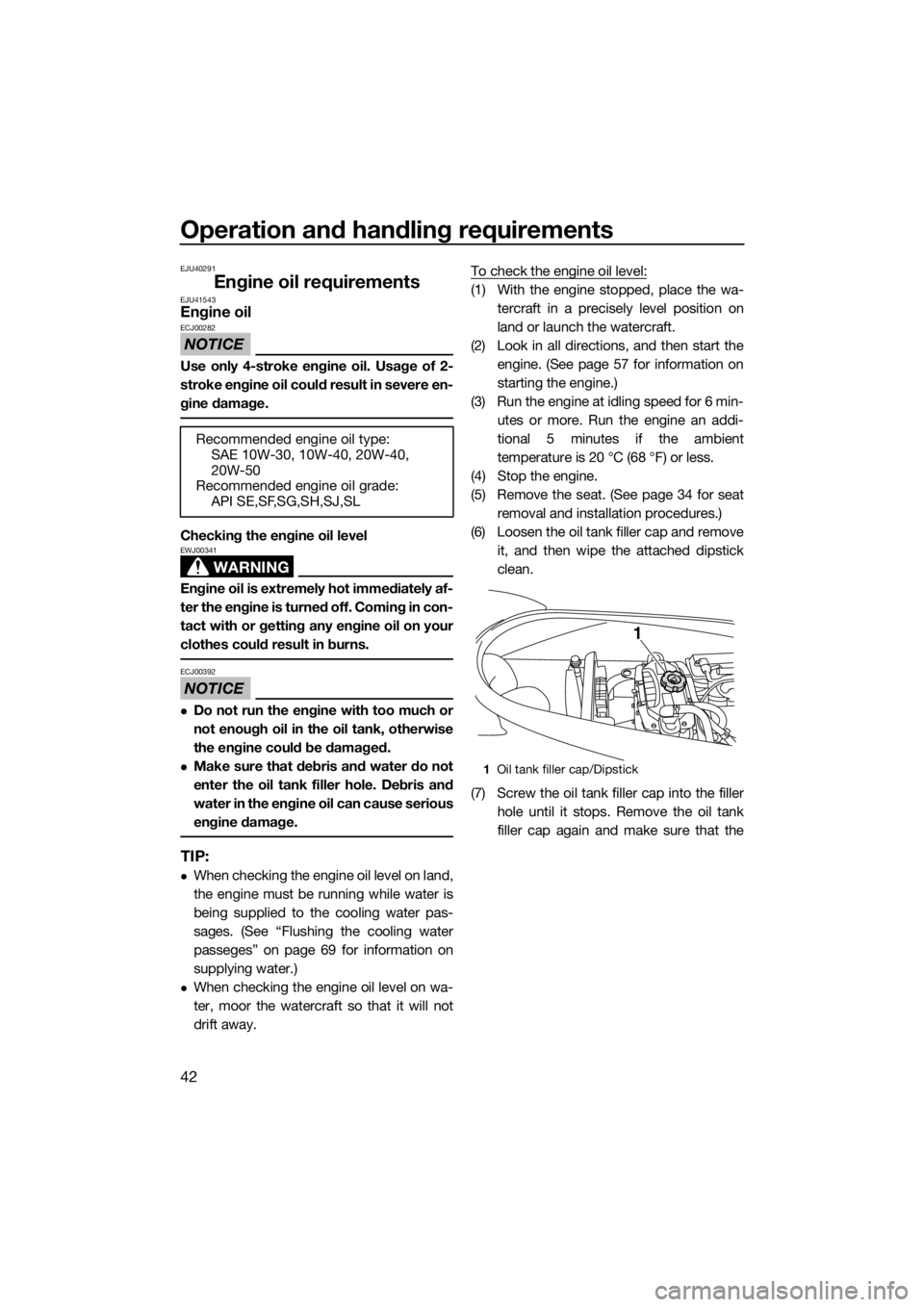
Operation and handling requirements
42
EJU40291
Engine oil requirementsEJU41543Engine oil
NOTICE
ECJ00282
Use only 4-stroke engine oil. Usage of 2-
stroke engine oil could result in severe en-
gine damage.
Checking the engine oil level
WARNING
EWJ00341
Engine oil is extremely hot immediately af-
ter the engine is turned off. Coming in con-
tact with or getting any engine oil on your
clothes could result in burns.
NOTICE
ECJ00392
Do not run the engine with too much or
not enough oil in the oil tank, otherwise
the engine could be damaged.
Make sure that debris and water do not
enter the oil tank filler hole. Debris and
water in the engine oil can cause serious
engine damage.
TIP:
When checking the engine oil level on land,
the engine must be running while water is
being supplied to the cooling water pas-
sages. (See “Flushing the cooling water
passeges” on page 69 for information on
supplying water.)
When checking the engine oil level on wa-
ter, moor the watercraft so that it will not
drift away.To check the engine oil level:
(1) With the engine stopped, place the wa-
tercraft in a precisely level position on
land or launch the watercraft.
(2) Look in all directions, and then start the
engine. (See page 57 for information on
starting the engine.)
(3) Run the engine at idling speed for 6 min-
utes or more. Run the engine an addi-
tional 5 minutes if the ambient
temperature is 20 °C (68 °F) or less.
(4) Stop the engine.
(5) Remove the seat. (See page 34 for seat
removal and installation procedures.)
(6) Loosen the oil tank filler cap and remove
it, and then wipe the attached dipstick
clean.
(7) Screw the oil tank filler cap into the filler
hole until it stops. Remove the oil tank
filler cap again and make sure that the Recommended engine oil type:
SAE 10W-30, 10W-40, 20W-40,
20W-50
Recommended engine oil grade:
API SE,SF,SG,SH,SJ,SL
1Oil tank filler cap/Dipstick
1
UF2P72E0.book Page 42 Tuesday, August 26, 2014 10:08 AM
Page 49 of 94
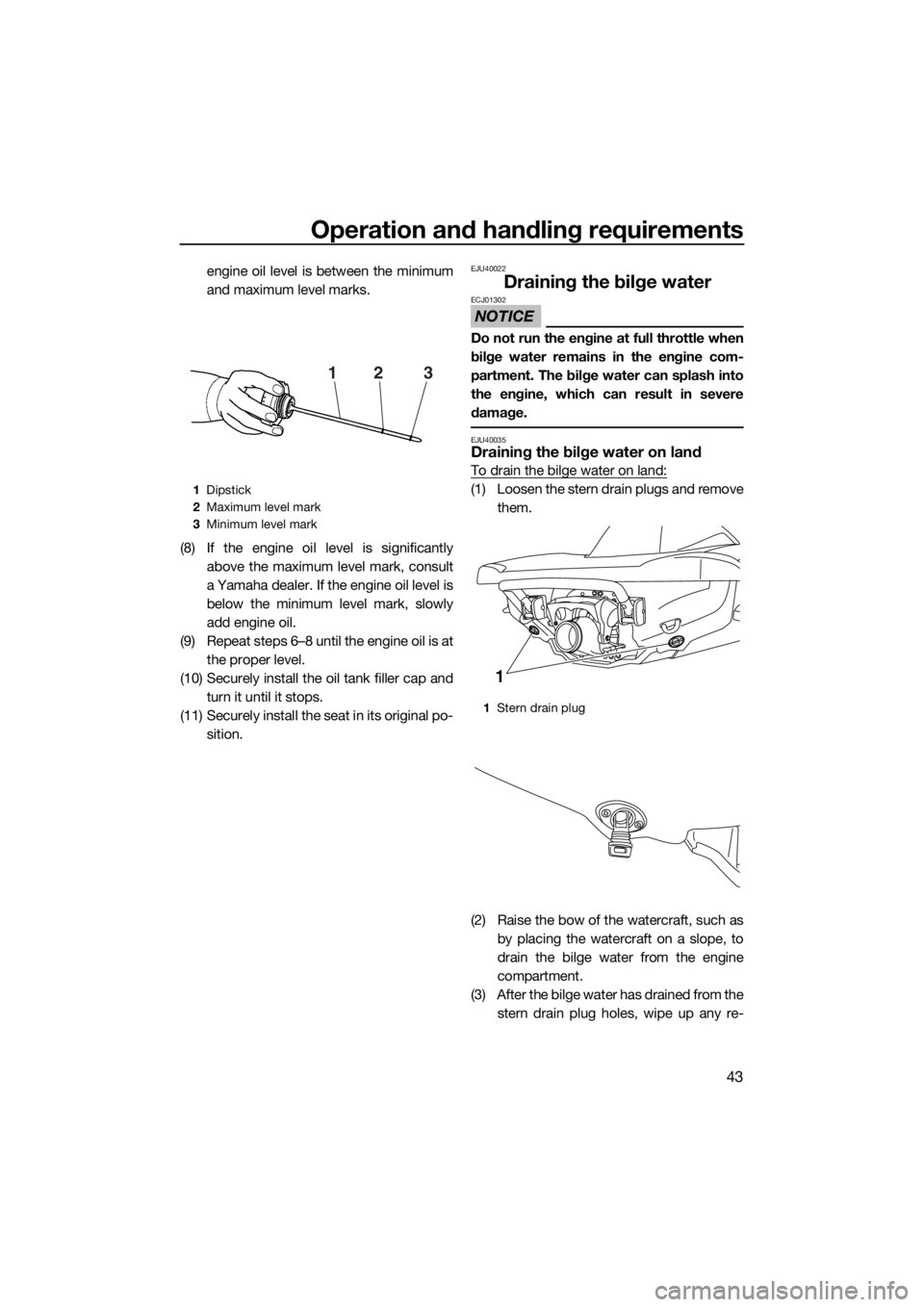
Operation and handling requirements
43
engine oil level is between the minimum
and maximum level marks.
(8) If the engine oil level is significantly
above the maximum level mark, consult
a Yamaha dealer. If the engine oil level is
below the minimum level mark, slowly
add engine oil.
(9) Repeat steps 6–8 until the engine oil is at
the proper level.
(10) Securely install the oil tank filler cap and
turn it until it stops.
(11) Securely install the seat in its original po-
sition.EJU40022
Draining the bilge water
NOTICE
ECJ01302
Do not run the engine at full throttle when
bilge water remains in the engine com-
partment. The bilge water can splash into
the engine, which can result in severe
damage.
EJU40035Draining the bilge water on land
To drain the bilge water on land:
(1) Loosen the stern drain plugs and remove
them.
(2) Raise the bow of the watercraft, such as
by placing the watercraft on a slope, to
drain the bilge water from the engine
compartment.
(3) After the bilge water has drained from the
stern drain plug holes, wipe up any re-1Dipstick
2Maximum level mark
3Minimum level mark
213
1Stern drain plug
1
UF2P72E0.book Page 43 Tuesday, August 26, 2014 10:08 AM
Page 50 of 94
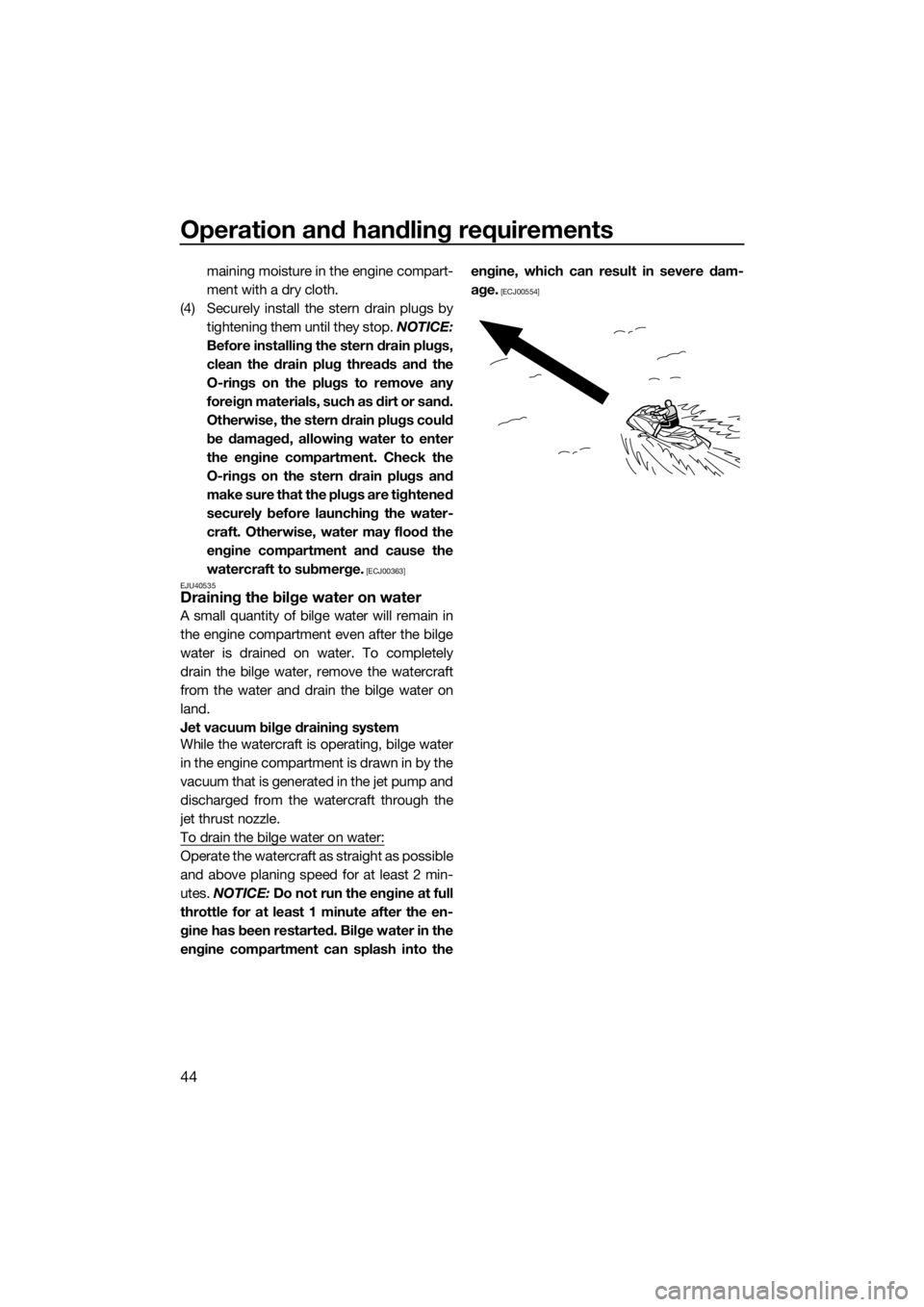
Operation and handling requirements
44
maining moisture in the engine compart-
ment with a dry cloth.
(4) Securely install the stern drain plugs by
tightening them until they stop. NOTICE:
Before installing the stern drain plugs,
clean the drain plug threads and the
O-rings on the plugs to remove any
foreign materials, such as dirt or sand.
Otherwise, the stern drain plugs could
be damaged, allowing water to enter
the engine compartment. Check the
O-rings on the stern drain plugs and
make sure that the plugs are tightened
securely before launching the water-
craft. Otherwise, water may flood the
engine compartment and cause the
watercraft to submerge.
[ECJ00363]
EJU40535
Draining the bilge water on water
A small quantity of bilge water will remain in
the engine compartment even after the bilge
water is drained on water. To completely
drain the bilge water, remove the watercraft
from the water and drain the bilge water on
land.
Jet vacuum bilge draining system
While the watercraft is operating, bilge water
in the engine compartment is drawn in by the
vacuum that is generated in the jet pump and
discharged from the watercraft through the
jet thrust nozzle.
To drain the bilge water on water:
Operate the watercraft as straight as possible
and above planing speed for at least 2 min-
utes. NOTICE: Do not run the engine at full
throttle for at least 1 minute after the en-
gine has been restarted. Bilge water in the
engine compartment can splash into theengine, which can result in severe dam-
age.
[ECJ00554]
UF2P72E0.book Page 44 Tuesday, August 26, 2014 10:08 AM